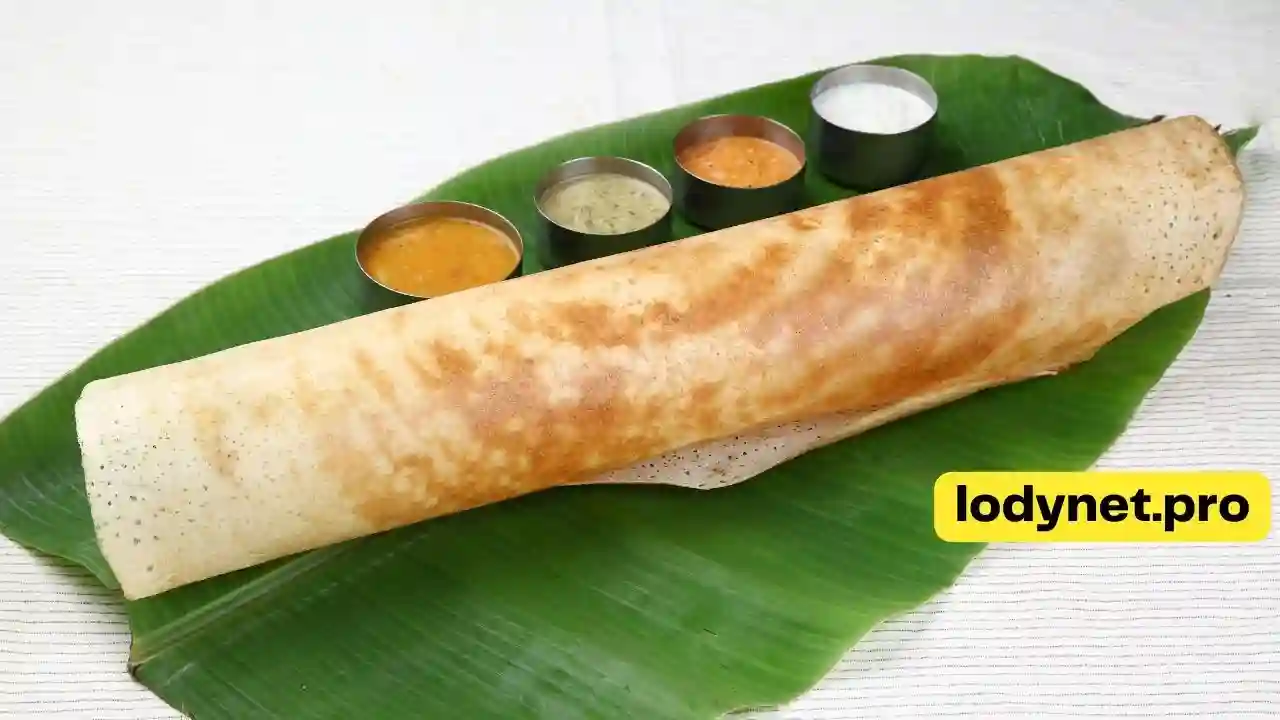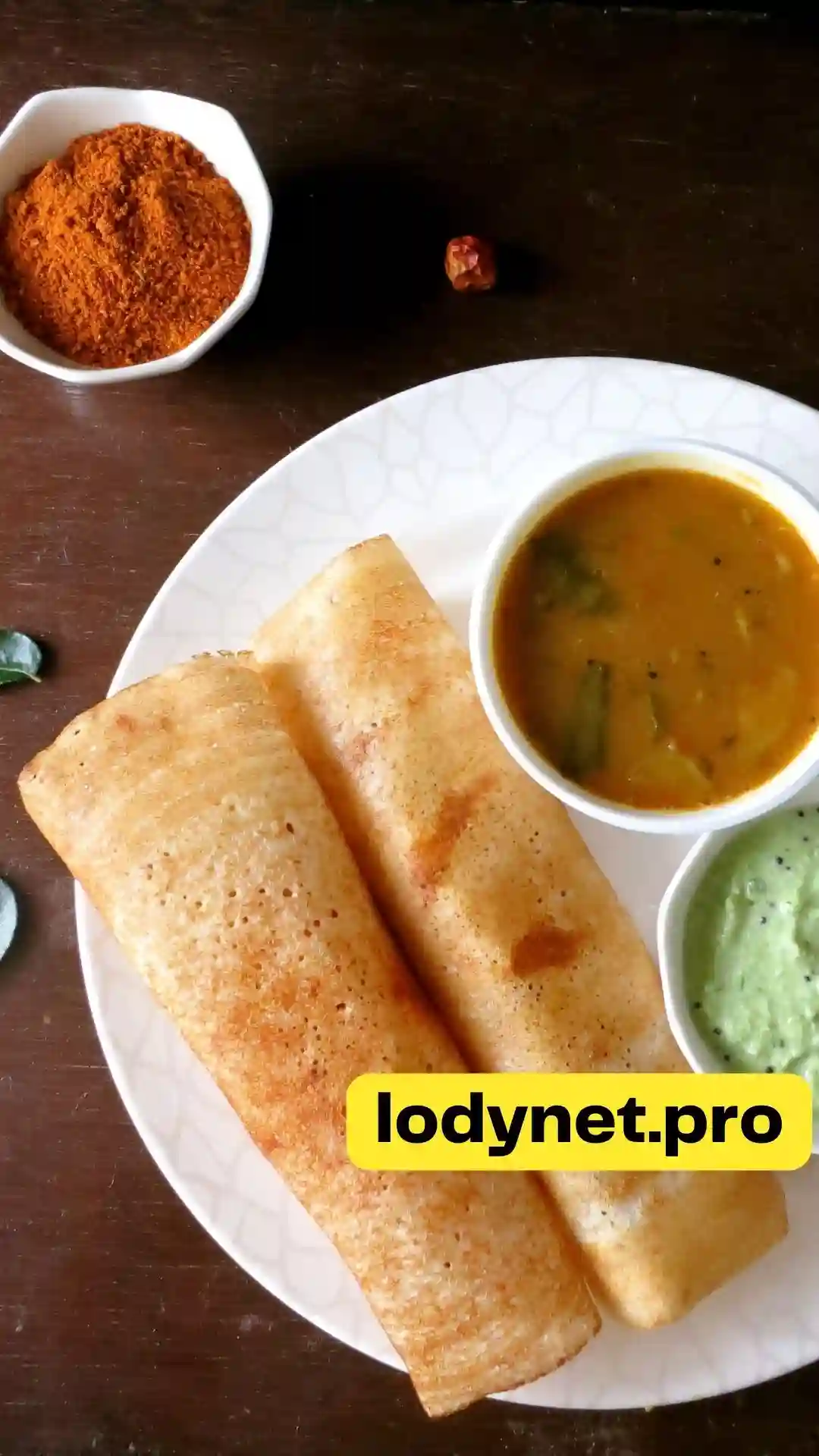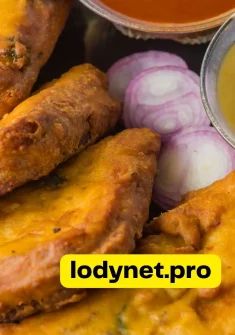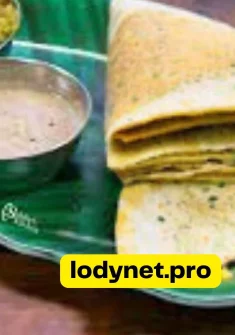Recipe for unique, delicious, and aromatic masala dosas in your kitchen with this tutorial and step-by-process. Masala dosa is among the most sought-after South Indian breakfast dishes served in tiffin and restaurant establishments. Dosa is a crepe that is made from lentil batter and fermented rice. Masala Dosa is fresh, fragrant, and tasty and comes with potatoes or spices cooked potatoes that are stuffed inside it.

The crispy crepes are tasty and addictive. Everyone wants to finish eating one, and that’s a sign of how good they are!
Masala Dosa Recipe
Masala dosa is one of the most popular South Indian breakfasts, where a crisp crepe made from fermented flour and lentils is served along with a flavorful spicy potato curry. It’s an excellent dish, as it comes with potatoes, masala, coconut Chutney, and Sambar.
It is thought that Masala dosa was originally a part of the Tuluva Mangalorean cuisine from Karnataka (source Wikipedia). Udupi restaurant chains made this delicious food extremely popular across India, which is why it is famous worldwide.
Many South Indian households make dosas frequently, and every home is unique in its recipe. Making your masala dosa is easy since it can be prepared using any dosa batter. It doesn’t require jambar or chutney since the masala of potatoes is sufficient enough.
However, making an excellent specially-prepared masala dosa that resembles a restaurant at home requires experimenting several times. In the past, I’ve tried a variety of recipes because they’re essential in the kitchen. I’ve also posted a combination of the latest ideas and tricks for making special masala dosas at South Indian restaurants.
A specially prepared restaurant-style masala dosa can be richer in flavor than the regular crisp dosa we cook at home. The proportions of dal, rice, methi, chana daal, and poha differ from the ingredients.
The recipe for making masala dosa batter can differ from one state to the next and from one place to another. Some places serve extremely thin dosas, whereas others offer a more crisp but slightly thicker variety.
Dosas made of masala are primarily found in Udupi restaurants, MTR chains & many Tiffin centers in Bangalore.
Other than rice, urad dal, and chana dal, other often used ingredients at restaurant kitchens are semolina, rice flour, and Chiroti rava; some use all-purpose flour and Sabudana. These all contribute to the taste and texture.
There are many formulas or recipes for making the perfect masala dosas. However, plenty of techniques and suggestions can help you create delicious dosas – fragrant fresh, golden, and crispy.

Preparation for masala dosa
Bake the Batter
- Include half a cup of urad Dal along with 3 tablespoons of chana daal and half a teaspoon of methi seeds in a bowl or pot of a large size. Additionally, measure 3 tablespoons of poha, and put aside. Rinse and soak for 30 mins before mixing the batter.
- You can also take 1 1/2 cups of raw rice and 1 cup of Idli rice (optional). It is also possible to utilize only uncooked rice. Place them in a large bowl.
- Clean and soak them in separate soaking for between 4 and 5 hours.
- The water in the dal should be removed. Place poha and dal into the blender container with 1/4 cup of water, and add salt as required. Salt can be skipped for those who live in an area with high temperatures. With no salt added, my batter isn’t able to ferment. This is why I mix it with salt.
- Mix them into an emulsifying batter that’s fluffy and bubbly. The batter should not be too thick or fluid at this point.
- Put it into an empty bowl. Make use of ceramic or glass bowls in a hot area. It will stop the batter from becoming bitter.
- Mix rice and half a cup of water until you have a slightly rough (fine semolina-like texture) or a smooth and creamy batter, according to your preference. Blend the rice into two groups if you’re using a tiny blender.
- If you are in need, add 1/4 cup of water.
- Add it to the bowl along with the dal batter.
- Mix all ingredients well.
- Allow to sit in a warm location for up to 6 hours, based on your temperatures or climate.
How do I make masala dosa batter ferment?
- The batter should be covered and kept warm to let it ferment until the batter has risen and is somewhat bubbly. Put it on the counter overnight if you are in a warm area. The time range is five to sixteen hours, based on the temperatures.
If you reside in a colder region, heat your oven to the lowest setting of 120 F (or 50 C for ten minutes. Shut off the oven and place the batter inside. If it is cold, following the oven’s heating, you can turn on the oven’s lights. Using the yogurt setting is also possible to use the instant pot for fermentation. Make sure you use an outer lid, and avoid an IP lid.
I let it ferment over 6 to 7 hours either in the oven or in my Instant Pot for six hours. Ensure not to over-ferment the batter because having a very thin batter in this recipe is not a good idea.
Test for fermentation to determine whether masala dosa has been properly fermented; pour half of the batter into the bowl that is filled with water. A well-fermented batter should float and not sink.
Making potato masala for dosa
- The next day, cook or boil the potatoes, but avoid creating mush. They can be cooked in a pressure cooker. You can add diced and peeled potatoes into a bowl and water until it covers the potatoes. Then place it in the pressure cooker. Let it whistle three times. When the potatoes are boiling in the pressure cooker, soak 1 teaspoon of the chana dal and 1 teaspoon of urad dal in a small amount of warm water for about 30 minutes to soften them. Then, drain the water and put it to use for the following stage.
- A pan is heated with 1 tbsp of oil. Cook 1/2 tsp cumin, 3/4 teaspoon mustard seeds, 1 tsp chana daal, and 1 teaspoon urad dal. I made use of yellow mustard because I had run out of ingredients. As the days became golden, I added Hing.
- Incorporate grated ginger, and cook until the scent comes through.
- Sliced onions, cut green chilies, and curry leaves.
- Cook until the onions are lightly golden.
- Chop the potatoes into a fine powder and then mix them into the dish along with turmeric and salt.
- Add 2 tablespoons of freshly boiled potato or water. You can leave the water out here if your potatoes have become soft.
- Sauté well for two minutes, then chop coriander leaves. Keep this dish aside.
How to make masala dosa?
- Adding a little water must bring the masala dosa batter to the desired consistency. It should have an even consistency. If you want brown dosas, add 1 teaspoon of powdered sugar. I have yet to succeed with this method, but some restaurants use a small amount of sugar.
- Place the pan over a low flame. If you’re using a cast-iron pan, drizzle a few drops of oil, then apply it to the pan using a chopped onion.
Mix the batter into the bowl if the pan has become hot enough. Then, take the batter in a small amount. Place it into the middle of the hot skillet.
- Then, spread the batter from the middle using your hands counterclockwise, creating circles until you reach the edges. Watch the video to learn thin or thick dosas using this batter. You can add 1/4-1/2 tsp butter or oil to the edges.
- It will turn slightly brown and cooked. Turn it over and cook the opposite side. Then flip it and cook until the masala dosa becomes light brown to golden. There is a possibility of getting dark brown dosas from this batter. Ensure to cook it on medium-high when the batter is about half-cooked. The potato masala should be placed in the middle of a dosa.
- If you are making masala dosa with Mysore, follow the directions on the above recipe card to prepare the red chutney. Make a smear of the chutney according to your preference, and then add the curry potato. Roll it out or fold it.
Serve masala dosa with crispy masala hot, accompanied by coconut Chutney and the tiffin sambar.
Faqs
What is the masala used that is used in masala dosa?
Masala is a spicy potato filling prepared by boiling potatoes and tempering them with spice and herbs. It’s also called aloo masala or dosa masala.
Is masala dosa unhealthy?
Homemade masala dosas, taken in moderation, are healthy. The masala dosas in hotels, restaurants, and on-street food are filled with calories because they contain lots of butter and high-carb ingredients such as refined flour are added to the various varieties. Additionally, more rice is utilized.
How do you create nutritious masala dosa?
There are various ways to lower the amount of carbs contained in this recipe. Cut down the amount of rice used to 1.5 cups per recipe. You can also use 1 part brown rice in two pieces of white rice. Adding millet in addition to two portions of rice is also possible. Cut down on the portion size of potatoes for nutritious masala dosas.
Pro Tips
Strategies to create golden and crisp masala dosa
Beyond the recipe, the perfect grill and a stove are essential in making perfect masala dosas.
Pan/griddle: The ability to cook crispy dosas on an iron skillet and in a thick-bottomed nonstick pan. Cast iron pans don’t only provide crispness, however. They also offer that dark golden color and distinctive scent. If you want those rich golden-brown dosas, you should use a cast iron skillet. I have a 10-inch cast iron pan and a heavier bottom nonstick pan to make these dosas.
The standard nonstick pot will not help you create the crispest dosas, which are golden. Select a pan with an extra-heavy bottom and an additional metal layer fixed on the bottom to ensure evenly distributed heat.
Restaurants employ large griddles/ Tawas that are made from the iron of cast iron, soapstone, or even steel. They’re constantly heated or on fire for hours, so they hold heat very effectively and make rich, fragrant golden dosas that don’t burn them. Making this in your kitchen is impossible since we can only cook on the grill for many hours the way they are.
Stove: The correct stove model is essential to ensure they are the top. Choose the most powerful burner for the stove. Ensure that the stove’s heat reaches the edges of the pan to ensure that the masala dosas are cooked evenly throughout and then turn crisp and golden. Many restaurants have big burners or electronic dosa makers on their stoves to make the dosas cook evenly.
If you frequently cook dosas with a deep golden color at home, consider having an individual set-up in your kitchen. This can be done using an excellent stove with a great burner and cast iron grid.
Faqs about golden, crisp masala dosas
Most of these questions come from the comments on my dosa recipes on my blog. We decided to answer these questions here to assist beginners.
Do I have the ability to make crisp dosas using a nonstick baking pan?
You can make crispy dosas using a nonstick pan with a sturdy bottom. For crisp dosas to be made, the most important thing is the proper rice-to-dal ratio, the right consistency of the batter, and using a pan with a large bottom that evenly heats.
Does it allow me to cook golden dosas using a nonstick skillet?
It is possible to do this if it has a thick bottom. Toast the masala dosas over the stove at a medium temperature. Make sure the flame can reach the entire bottom of the pan uniformly. Additionally, using plenty of fats such as oil/butter/ghee/butter for cooking them helps.
How can I get the deep golden brown masala dosas using a nonstick oven?
A pot continuously heated for extended periods can produce brown to golden masala dosas. Heating a nonstick stove to that level for a long time isn’t ideal. If you like rich golden dosas, use a cast iron grille.
Helpful tips and FAQs for making the batter
Do I need to soak and mix rice and dal separately?
In fact, it’s a good idea to soak and blend the two separately. Most methi seeds, as well as dal, are soaked and ground since the batter needs to be extremely soft and smooth. It is essential to avoid any bits or coarse methi seeds remaining in the batter because they can taste bitter. The rice is crushed to create a fine texture of semolina, which adds a crisp feel to the dosa.
But you can soak and blend them with a large container and a high-speed blender.
How do I calculate the proportion of rice to dal?
Typically, a ratio of 4:1 is used to make masala dosa because a more significant amount of chana daal is utilized. Also, I make it with a balance of 3:1, which I’ve listed in the recipe note in the recipe notes below.
What type of rice do you recommend?
Most of the time, I utilize only uncooked sona masuri rice since this is the type of rice that we used back in India. Sometimes I will use 3 portions of uncooked sona masuri rice and 1 part of idli or parboiled rice based on what is available.
Parboiled rice can be substituted or idli with raw rice, but it is not the reverse. There are various kinds of rice parboiled, and many need to be more suitable for this recipe when used in more significant amounts.
I’ve also cooked good masala dosas from cooked basmati rice that has been aged. The recipe is in the notes.
Can I use split urad dal?
You can use the same amount divided by the urad dal.
Why is chana daal or toor daal employed?
Chana daal and toor dal are both used for smell and for a rich golden color. You may use chana dal if you prefer something other than toor dal.
Why methi seeds and poha are being used?
Methi seeds can help reduce dosas’ tough, rough, and flaky texture without turning them soft. If you don’t have methi or poha, the dosas can become dry and irritate the mouth when you consume them. It’s best to choose at least one.
FAQs and tips on the fermentation of batter
How long do I need to let it ferment?
The recipe is dependent on the circumstances. Double this recipe, and then transfer the batter into two bowls. I then ferment one bowl of batter by baking it by turning the oven’s light on while I ferment the other one in my Instant Pot for 7 hours. The fact that you can ferment in two different locations can be advantageous. If one of them ferments, it is possible to combine them and reduce the airiness.
What should I be fermenting?
Masala dosa batter is not going to require much fermentation. In the case of idlis, we ferment until the batter is doubled, as we like them to be fluffy. However, for dosas, the batter must be fermented less. The fermentation process can cause the batter to be too thin silky, soft, and light. The batter won’t be able to make the batter spread evenly.
How do you know when the batter is sufficiently fermented?
Once the batter is fermented, it will increase in size. I generally make my batter bowl full to 50% and believe it’s finished when it has reached up to 3/4 of my bowl. This means that you will ferment it once it’s doubled.
How can batter be stored to last longer?
Fermented batter is good for three days when stored in the refrigerator. After that, it becomes sour unless you reside in icy areas. If you don’t like sour sweet dosas, you can keep the batter in the refrigerator without fermentation. The not fermented batter can be stored in the fridge for 3 to four weeks.
Do I have to use the batter to make other dishes?
You can use the same batter to make uttapam as well as paniyaram. There is a variety of masala Dosas, such as masala dosa from Mysore, schezwan masala dosa, Mumbai masala dosa, Chettinad masala chicken Thosai, etc. It is also possible to make all of them using similar batter.
I also have shared how to make the red chutney spice mix used to spread over the masala dosa of Mysore, which is how it differs from the standard masala dosa.
Strategies to make and store the batter to make more significant amounts
I sometimes use my wet grinder to make an enormous batch of dosa batter. It lasts for three to four weeks. Place the batter in different containers, and then refrigerate it without fermentation.
In case I’m in need, I take one of these containers on hand from the night before. However, this batter will take some time to make.
Strategies for making great masala dosa
Congruity of batter: Bring the batter to the proper consistency. It should be dense, thick, moderately dense, and have a pouring surface. The batter must not appear too thin and airy. After fermentation, the batter tends to become heavier. Therefore, add water and mix it back to the proper consistency. Go through the video to determine the ideal consistency.
Make sure to grease the pan: If you are using a nonstick pan, it is unnecessary to lubricate it at any point. If you are using a cast iron skillet, heat it before adding a couple of drops of oil. Rub it across the pan, using a cut onion.
The pan is heated: Ensure the pan is warm before pouring the batter. It is better to cook the pan over medium rather than hot heating.
Check the temperature: Do not perform this test if you are you are using a nonstick skillet, as it can damage the coating and causes the pan to crack over time. The test can be used only applicable to cast iron pans. Add the pan with water to check if your cast iron skillet is hot enough. If it starts to sizzle, and the water evaporates gradually, the pan is hot sufficient to utilize.
What causes my batter to clump in the middle at the bottom of my pan?
If your pan is hot enough, the batter starts to form clumps and cook when you pour it. The batter will become difficult to even out. For fixing – lower your pan’s temperature until it is medium-hot. The pan should not be too hot.
How come I’m not able to distribute this batter?
If your batter becomes thick, distributing it won’t be easy. The other reason is due to fermentation. The batter fermented too long will become too thick and airy, preventing the batter from expanding. Add a small amount of water for a fix, and mix the batter well to decrease the airy feel.
What’s wrong with my masala dosas so soft and not crunchy?
Following the recipe shared in this article, you’ll always have crisp masala dosas unless you use excess water. If the batter is fluid, it will turn soft. Make sure to use less water the next time. If you are having trouble, add some rice flour, and mix it using your hands to break up the lumps.
What is the reason my dosa keeps sticking to my pan?
If you use a nonstick skillet, dosas won’t stay in place. With a cast-iron pan, they might stick if your pan needs to be adequately greased. When ready to begin making dosas, you must heat the pan initially. Sprinkle a couple of drops of oil on the pan. Massage it by cutting an onion. Then, cook the pan over medium heat, put the batter in, and make a spread.


